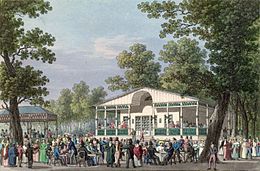Schweizerhäuschen (Leipzig)
The Swiss cottage was in Leipzig Rosental located café .
history

The cafe
In 1777 the historian Johann Gottlob Böhme , the owner of the Gohliser Schlösschen , had a footpath to Gohlis laid out from the Leipzig Rosentaltor along the Pleiße through the Rosental .
After it had already emerged in this way in 1782 a Eisbude ( "To Cold Madame"), opened 1824 in Davos coming confectioner Georg Kintschy (1794-1876) farther north on the other side of the path confectionery "Swiss houses". Built in wood, the building contained a hall, two small lounges and a rear-facing kitchen. There was a porch, a bandstand, and plenty of outdoor seating. The locality soon became “famous for sweets such as cream puffs, pancakes, Napoleon cakes as well as particularly excellent liqueurs and grog. The coffee music orchestra was the main attraction for young and old ”.
“Near Kintschy”, as the café was also called, frequented poets, painters, musicians and publishers, so that the place, at least in summer, developed into a cultural center. Here you could meet Karl Herloßsohn , Ludwig Bechstein , Heinrich Marschner , Albert Lortzing , Gustav Theodor Fechner or Heinrich Laube and later also Friedrich Nietzsche . The first public performance of a composition by Richard Wagner is said to have taken place in the music pavilion , probably aria number 3 in WWV .
In his book From Twenty to Thirty, Theodor Fontane describes a visit to the Schweizerhäuschen during his Leipzig year 1841/42 in the Adler pharmacy as follows:
- “ At six we prepared to take a swimming pool in the Elster or Pleiße - I think it was pretty much the place where Poniatowski had drowned - and an hour later we went to the» Rosental «, at the entrance of which we were used to separate us because everyone had their favorite spot. Back then there were two main bars, maybe they still exist under the same name: Bonorand and Kintschy. I thought of Kintschy. There were hardly any guests at such an early hour, and the whole lovely place was mine. A protruding roof resting on wooden pillars covered a porch with a gravel path in front, which the tall old trees overshadowed from the other side. There was a jubilation in every branch, and no sooner had my breakfast appeared than the sparrows were jumping around on my table. It was so lovely that I forgot even reading the journals, which at the time I was only too happy to waste my time with. "
On the occasion of a change of ownership, the Schweizerhäuschen was renovated in 1844/45.
Civic facilities
In 1927 the Leipzig Zoo expanded to the west. The way to Gohlis was integrated into the zoo, and from then on the Schweizerhäuschen accommodated bird cages and the like. In 1969 the zoo school was set up in the Schweizerhäuschen, where school classes completed parts of their biology lessons. In this way, the building, unsuitable for a zoo, was retained as the only Leipzig excursion restaurant from the Biedermeier period .
In 2001 the building was demolished and, taking historical details into account and applying today's building regulations, which the building no longer met, was faithfully rebuilt by the architect Adalbert Haberbeck. It now houses the “Hacienda Las Casas” restaurant as the first property in the South America area, the last area in the expansion of the Leipzig zoo.
Individual evidence
- ↑ Picture at Café Bonorand
- ^ Website Dorothe Ammermann
- ↑ Klassika Wagner work directory
- ^ Theodor Fontane: From twenty to thirty. Autobiographical. First edition: F. Fontane & Co., Berlin 1898, p. 73 (online at Zeno or gutenberg.de )
literature
- Wolfgang Hocquél : Leipzig. Architecture from the Romanesque to the present. 3rd, expanded edition. Passage-Verlag, Leipzig 2010, ISBN 978-3-932900-54-9 , p. 170 f.
- Horst Riedel: Stadtlexikon Leipzig from A to Z. Pro Leipzig, Leipzig 2005, ISBN 3-936508-03-8 , p. 509.
Web links
Coordinates: 51 ° 20 ′ 57.7 " N , 12 ° 22 ′ 2.8" E

